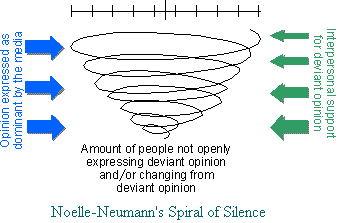Spiral of Silence

"Neumann (1974) introduced the “spiral of silence” as an attempt to explain in part how public opinion is formed. She wondered why the Germans supported wrong political positions that led to national defeat, humiliation and ruin in the 1930s-1940s.
The phrase "spiral of silence" actually refers to how people tend to remain silent when they feel that their views are in the minority. The model is based on three premises:
1) people have a "quasi-statistical organ," a sixth-sense if you will, which allows them to know the prevailing public opinion, even without access to polls,
2) people have a fear of isolation and know what behaviors will increase their likelihood of being socially isolated, and
3) people are reticent to express their minority views, primarily out of fear of being isolated.
The closer a person believes the opinion held is similar to the prevailing public opinion, the more they are willing to openly disclose that opinion in public. Then, if public sentiment changes, the person will recognize that the opinion is less in favor and will be less willing to express that opinion publicly. As the perceived distance between public opinion and a person's personal opinion grows, the more unlikely the person is to express their opinion."
© Universiteit Twente
More at http://www.tcw.utwente.nl/theorieenoverzicht/Levels%20of%20theories/macro/spiral_of_silence.doc/



Sem comentários:
Enviar um comentário